Camp enrollment is the process of registering young campers for any type of camp, be it a summer camp, day camp, or overnight camp.
It goes without saying that the primary purpose of this process is to keep existing campers returning while attracting new ones, thus ensuring your camp sessions are full and your organization’s cash flow is intact.
Of course, camp enrollment rates can be affected by external factors—such as increasing competition, changing demographics, and rising living costs—and by internal shortcomings that inadvertently turn prospective camper parents away.
Against this backdrop, this guide will first discuss four organizational problems affecting camp enrollment and then cover five ways for camps to increase their enrollment numbers.
What Problems Affect Camp Enrollment
Putting aside the external camp enrollment issues we mentioned, like keeping up with competition and inflation, the numbers of enrolled campers are often negatively affected by the camp organizers’ inability to efficiently manage the registration process.
But to be fair, they have a lot on their plate because camp enrollment can be a tricky business.
As a reminder, here are just some of the complex processes that camp enrollment teams have to manage:
- collecting all the necessary information from parents/guardians, including the child’s medical history and other relevant details
- ensuring all required forms, waivers, and permissions are completed and signed while addressing the parents’ inquiries and concerns
- managing payment processing and tracking payment status
- coordinating enrollment deadlines and waitlists, managing cancellations, refunds, and rescheduling requests
- ensuring regulatory compliance and information security
In light of this, it’s clear that any shortcomings in these processes can turn potential camper families away.
So, let’s first take a closer look at four common organizational problems that can hurt camp enrollment numbers—complicated registration process, limited payment options, inefficient communication, and lack of actionable reports.
Complicated Registration Process
If your camp registration process is too long and complicated, this can discourage prospective camper families from enrolling, or make them abandon the process halfway through, or submit incomplete or improperly filled-out forms.
For example, if parents have to contact the camp organizer to get their paper registration forms in the mail along with payment instructions, they might decide to look for more convenient options instead.
Even when registration forms can be completed online, multiple forms that ask for too much information can discourage prospective campers and their parents.
In such cases, even email reminders like this template might not get them back.
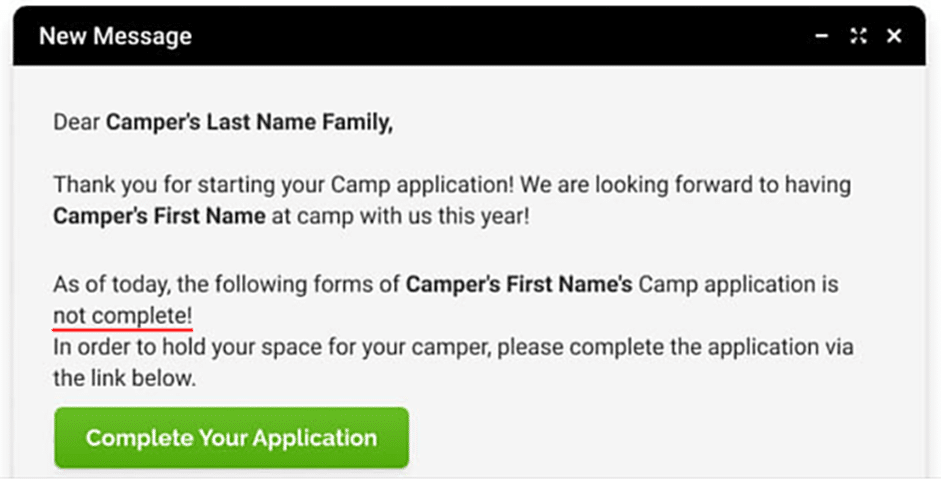
Source: Regpack
Other “don’ts” that can deter parents from registering their child for camp include:
- having to print, sign and scan forms
- being unable to see how many steps are left in the registration process
- parents with multiple children having to re-enter the same info for each child separately
To sum up, a complicated registration process can discourage parents from enrolling their children at camp.
Limited Payment Options
Providing parents of potential campers with limited payment options is one of the most common reasons parents give up their camp slot, especially given the current cost of living crisis.
For example, if the camp requires full payment upfront or offers inflexible payment plans, some parents will discard it as a viable option due to budgeting issues.
The same is true if applying for a payment plan includes separate forms, requires additional info, or if it can’t be done online.
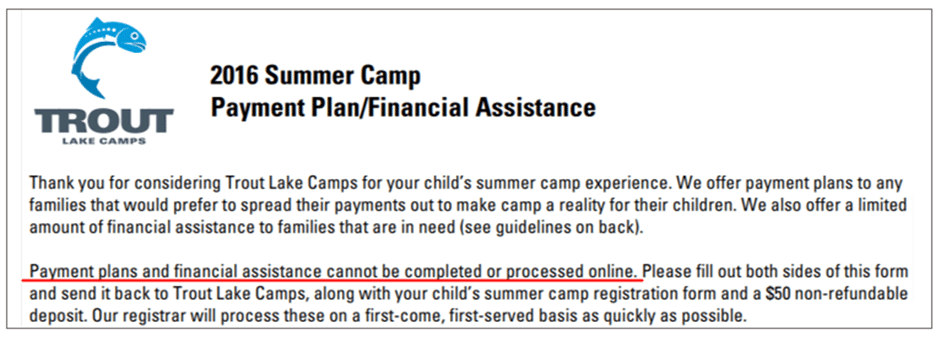
Source: Ultracamp
In other words, parents who want to spread out the cost of camp over a specific period and pay in installments should not be forced to go through an extensive administrative process to do so.
Naturally, the other example of limited payment options is when the camp only accepts traditional payment methods (cash, check, wire transfer), which some parents will find inconvenient and outdated.
Even when they have some online payment options, such as a bank transfer, they still might prefer to pay by credit card, PayPal, Apple Pay, or other payment apps/e-wallets.
Other payment-related problems that can act as deterrents for potential campers include:
- too many steps in the payment process
- hidden fees until the moment of payment
- insecure payment processing
Overall, inflexible, impractical, and limited payment options are among the major reasons parents may choose something else for their camper.
Therefore, best practices are to give them a wide variety of options for their convenience.
Inefficient Communication
Another common problem leading to camper dropouts—inefficient communication—occurs when parents consider several camps and encounter difficulties getting crucial information on time.
For example, let’s say a parent is interested in enrolling their child in several different camps for the summer months, and each camp has a different registration deadline.
If that parent can’t check their child’s registration status on their own (e.g., via an online registration portal), they’ll be forced to send emails or make phone calls.
In that case, if the camp is slow to communicate important information related to registration —such as the deadline for submitting payments or required medical forms—or fails to notify parents of problems with registration on time, they might miss the deadline and be prevented from enrolling.
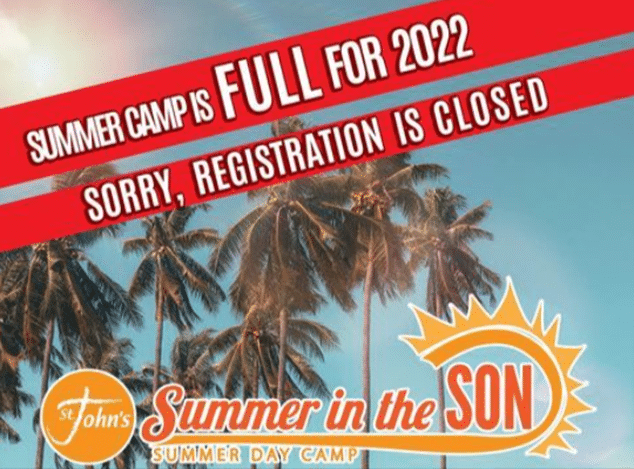
Source: SJLS
Alternatively, registrants might drop out even sooner, i.e., when they realize they don’t have the time or energy to deal with unclear requirements and tight deadlines resulting from the camp’s inefficient communication.
Lack of Actionable Reports
Unlike the first three problems, where we focused on the campers’ parents, this one involves the camp enrollment team and missed opportunities to increase enrollment numbers.
Namely, we’re referring to the fact that if camp organizers don’t have actionable reports based on the data they gathered, it’s difficult for them to track enrollment from the previous year and identify problems that are reducing camp enrollment rates.
For example, they might fail to understand which programs and activities are most popular among campers so they can adjust the camp’s offer accordingly.
Or they might miss that some marketing channels bring almost no registrants, and they should redirect their marketing efforts.

Source: Regpack
In essence, without proper data tracking and analysis—as preconditions for actionable reports—the camp enrollment team may struggle to understand why camp enrollment is decreasing, making it challenging to implement practical solutions.
Finally, the inability to use data-driven reports also aggravates decision-making in other areas that affect camp enrollment, such as pricing, staffing, and the camp’s offerings.
Therefore, a lack of actionable reports based on the collected data can greatly impact the camp enrollment team’s ability to improve enrollment numbers.
How to Increase Camp Enrollment
Now that we covered the organizational problems that can reduce enrollment numbers, let’s turn to how organizers can increase camp enrollment.
As you’ll see, the solutions suggested here are a mix of technology-based improvements and marketing techniques aimed at optimizing the enrollment process and maximizing the number of campers.
Of course, you might already be using some of them, but even so, you may still find a few good ideas that can help you improve enrollment rates.
Focus On Your Value Proposition
This first tip—focusing on your camp’s value proposition—is predicated upon knowing what sets your camp apart from others and what resonates with prospective campers and their parents.
From there, you can craft an appropriate marketing message and put your value proposition front and center in all marketing materials and communications.
According to Investopedia:
A value proposition in marketing is a concise statement of the benefits that a company is delivering to customers who buy its products or services.
In camp terms, this refers to unique benefits or advantages that a camp can offer.
For example, this day summer camp highlights field trips, flexible scheduling, and swimming skills as their specific selling points.

Source: WatchMeGrow
To determine the camp’s value proposition, camp leadership should perform a SWOT analysis, which involves analyzing the camp’s strengths, weaknesses, opportunities, and threats.
This is a perfect time to highlight that having and analyzing past camp enrollment data can significantly enhance SWOT analysis results, thus creating an accurate and up-to-date picture of the camp’s value proposition.
For example, based on the results, a specialty camp might decide to compensate for its lackluster facilities by highlighting its special outdoor adventures.
Overall, identifying your camp’s specific strengths along with what attracts potential campers and their parents and using this to focus your marketing strategies can help you boost enrollment numbers.
Encourage Early Registration
Early registration is a widely used strategy that helps camps secure their finances in advance, gives them more time to plan camp sessions and daily activities, and provides parents with a better user experience.
Of course, the most common and effective way of incentivizing parents of potential campers to commit to the camp well in advance is to offer an early bird discount.
Such discounts should be time-limited to create a sense of urgency.

Source: Macaroni Kid
Naturally, there are other less financially demanding or even free avenues you can take to encourage early registration, such as:
- providing early “limited time only” access to the most popular camp sessions
- giving away camp merchandise for registrations before a specific date
- opening next year’s camp registrations on the first or last day of this year’s camp
- offering an “early-bird” registration date for returning campers
Of course, deciding what incentives to use to boost early registration rates should be based on data-driven insights about what works best from your camp’s marketing and social media, financial, and operational perspectives.
Streamline the Registration Process
In order to avoid a complicated registration process, a good solution is to streamline it with the help of camp registration software so that prospective campers and parents can quickly and easily register without much trouble.
In fact, such camp software will either solve or minimize all the organizational problems affecting enrollment we discussed above.
In other words, the right software solution should address issues like overly complicated registration forms, inflexible payment plans and inconvenient payment options, late communication, and lack of data-based reporting.
Our online registration system, Regpack, offers customizable enrollment forms and integrated payment options embedded on your website, making the entire enrollment process quick and easy.
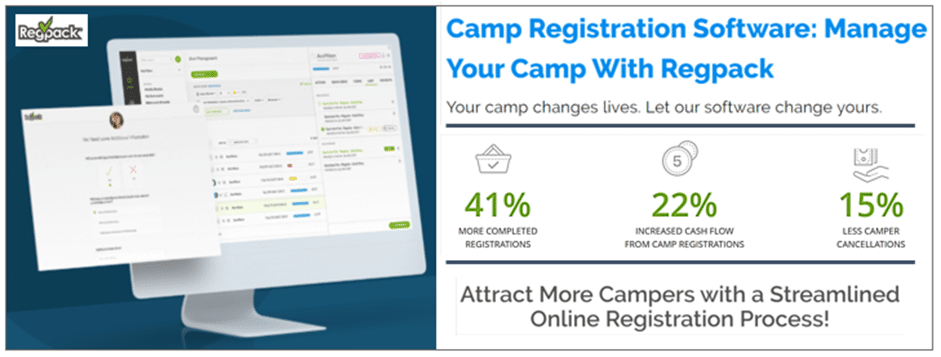
Source: Regpack
For instance, parents sending more than one child to your camp can use the family registration option so they don’t have to re-enter the same data for each child and can also manage camp fee payments from one place—their secure billing portal.
The registration process is easy to navigate, and registration forms are intuitive, relying on conditional logic.
This means that the parents’ answers will influence which subsequent questions they’ll be asked.
As for signing different forms, waivers, and permissions, Regpack offers various electronic signature options, depending on your camp’s preferences.
Needless to say, all these features streamline the registration process and solve many problems along the way, which makes camp registration software essential for improving parents’ enrollment experience and increasing camper sign-ups.
Develop a Communication Strategy
As said, inefficient communication can hurt enrollment numbers in more ways than one, from slow responses, misunderstandings, and missed deadlines to misaligned marketing efforts.
Conversely, developing a communication strategy—for the period leading up to enrollment, the period during enrollment, and the period after camp ends—allows camp organizers to address all these issues in an organized and efficient manner.
In other words, the focus of camp communication shifts slightly in each of these stages to ensure that relevant information is reliably communicated to returning and new campers.
Furthermore, the online platform camp organizers can use to implement their communication strategy and automate many related processes is the one we just mentioned—camp registration software.
Namely, the software of your choice should allow you to automate email communication on a mass scale, filter the emailing list as you want, and create trigger-based email workflows.
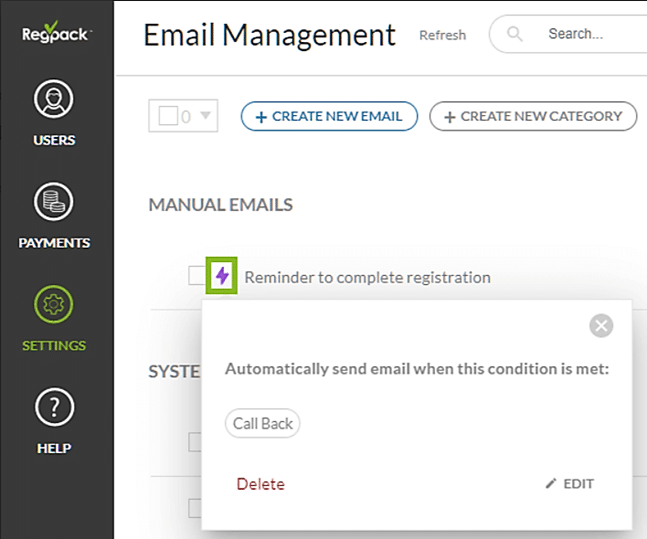
Source: Regpack
For instance—in the period leading up to enrollment—this email tool can be used to automate sending out personalized emails to returning camper families as a reminder of the great time they had last year while highlighting any exciting add-ons for this year.
Likewise, it can be used for targeted communication with potential new campers.
However, email automation really shows its value during the enrollment phase.
Simply put, it ensures that critical information needed for successful registration, such as enrollment requirements, payment deadlines, and billing schedules, is consistently communicated to relevant persons throughout the process.
To sum up, an effective communication strategy backed up by email automation can streamline camp organization processes, reduce errors and miscommunications, enhance camper and parent satisfaction, and ultimately increase enrollment.
Take Action to Retain Your Campers
Proactively working on retaining your campers makes sure the efforts invested in increasing enrollment are not wasted.
Obviously, after the camp is over, you want as many of your campers to return next year, once they are familiar with what your camp provides and, as such, become the best kind of business—repeat customers.
However, considering that your returning campers—and their younger siblings—will eventually age out of camp, they are also your best and only source of word-of-mouth referrals and positive online and offline testimonials that attract potential new campers.
Also, their feedback is the ultimate source of invaluable information on how to improve enrollment numbers.
The best way to gather feedback is by sending out a survey to campers and their parents while their camp experience is still fresh in their minds.
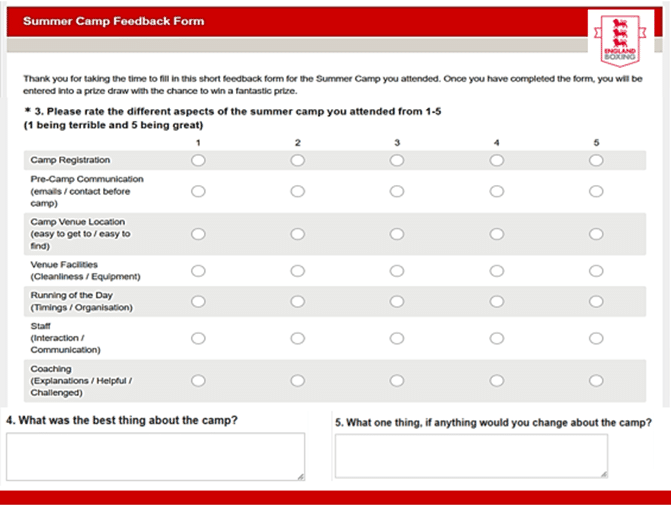
Source: Survey Monkey
In essence, surveys and other forms of feedback provide insights into what campers and families liked and disliked about your camp, helping you understand what can be improved to retain those campers and attract new ones.
Other camper retention boosting actions can, as mentioned, include personalized emails reminding families of positive experiences their children and they had with your camp, as well as sharing testimonials and success stories from past campers.
Naturally, this communication should also advertise any new programs and activities planned for the next camp and include special discounts or other perks for referrals and early registration or other eligible students.
Overall, taking action to retain your campers through feedback and follow-up communication can ensure that other efforts to increase enrollment have strong foundations to build on.
Conclusion
If we wanted to boil down this guide to one takeaway, it would be that camps can solve or minimize many problems affecting the number of enrolled campers.
They can do that by using a combination of smart strategies supported by advanced tools provided by camp management software.
Furthermore, they can use the same approach to streamline the entire enrollment process for both parents and camp staff members, resulting in a smoother enrollment experience for everyone involved and increasing camp enrollment rates.













